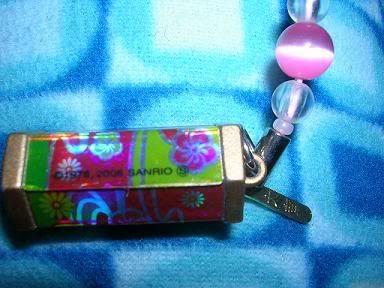I guess Sanrio wasn’t getting enough business in Eastern Tennessee (everything but the stickers seemed overly expensive, but that might just be the impression of a little girl just learning how to count money) and they eventually shut down all their shops. As far as I know, Sanrio stores don’t exist in America anymore (at least not in the cities I’ve been to). Now, Hello Kitty is best found in a cutesy store that sells Breyer horse figurines, collectable dolls, beanie babies, angel figurines and those collectable miniature buildings that most people just display around Christmas, or in garage sales and flea markets, if you don’t mind your Hello Kitty second-hand. But in Japan…
Hello Kitty occupies a much wider market in Japan. Go to any city in Japan and there will be a Hello Kitty keitai strap to commemorate your visit to that city. Some are easier to understand, such as the Osaka Hello Kitty, while others require a little more thought, for instance, Hiroshima Hello Kitty is riding on a dove. But this isn’t just any dove, this dove has a green plant sticking out of its mouth. So, to me, the Hiroshima Hello Kitty seems more like a Noah’s Ark Hello Kitty than anything else, but when you visit Hiroshima Peace Park, the dove suddenly makes sense. Hello Kitty keitai straps aren’t limited to cities though; there are plenty of other varieties…

I bought this the day I arrived in Japan and I had no idea what it was except that it had Hello Kitty on it. But, I liked how it looked. I’m sure someone will give me the correct Japanese name for this thing, but this is basically the instrument used at temples and shrines in Japan to give you your fortune. Whenever I shake it, it always gives me the “best” fortune so I thought it was rigged until someone else tried it and got a different fortune. Maybe it just likes me.

Your local Sanrio Store, found in Shinsaibashi. This picture is a bit old (it's decked out for Halloween) but it illustrates my point. I have never seen a sanrio store on this sort of scale before. The Shinsaibashi branch has three stories of Hello Kitty stamped on everything imaginable. I’m pretty sure I saw the kitchen sink in there too.
I bring Hello Kitty up in relation to Japanese culture for a two reasons. First, Hello Kitty is obviously from Japan and has been exported all over the world (globalization!). But secondly (and perhaps more importantly), after exportation, Hello Kitty takes on a slightly different meaning (at least in America). For instance, after Sanrio decreased their number of stores in America in the early 1990s, there was a period of time in which Hello Kitty or any Sanrio products could be found. When Hello Kitty resurfaced, most Americans remembered her from their childhood and thus think of Hello Kitty as a child’s product. Though adults in America still buy some Hello Kitty products, this is mainly done out of nostalgia for our childhood and having too many Hello Kitty products is generally seen as being really childish and almost immature. Several other items from our childhood suffer the same fate (I’ll cite My Little Pony, Littlest Pet Shop, Polly Pockets, and several other toys as my examples); most have been revived because the generation that played with them as kids are beginning to have children of their own and want to pass on the joys of their own childhood to their children.
In Japan, there wasn’t a temporary disappearance of Hello Kitty, so Hello Kitty doesn’t strictly occupy the childhood niche she holds in America. It is perfectly acceptable in Japan to be collecting the Hello Kitty City Keitai straps even as an adult, to have a Hello Kitty eyeglass case (such as the eldest of my two host sisters), to proudly carry a Hello Kitty handbag (as I saw someone doing this morning) or to own other Hello Kitty products.
2 comments:
May I add Pokemon to the list of Japan stuff that has gained a kiddie meaning in the USA?
(okay, it's getting somewhat popular in the USA again thx to Diamond/Pearl)
Kitty-chan is a great example of globalization. Did you know she was actually born in London (so her limited story goes...)? Check out
Hello Kitty: the remarkable story of Sanrio and the billion dollar feline phenomenon by Ken Belson and Brian Bremner (2004).
As for your photos, it might have been more interesting to see people interacting with Kitty-chan products. For example, in the administration building of a certain university, there is a young female worker who has a Hello Kitty blanket draped from her chair. It is very out of place in the serious office filled with stuffy old men. How does she get away with it?
I like your personal stories in your posts, but I would like to see you move beyond your reflexive style and focus on Japanese people.
Post a Comment